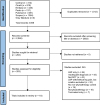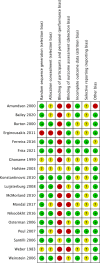How effective are physiotherapy interventions in treating people with sciatica? A systematic review and meta-analysis
- PMID: 36580149
- PMCID: PMC9925551
- DOI: 10.1007/s00586-022-07356-y
How effective are physiotherapy interventions in treating people with sciatica? A systematic review and meta-analysis
Abstract
Purpose: Physiotherapy interventions are prescribed as first-line treatment for people with sciatica; however, their effectiveness remains controversial. The purpose of this systematic review was to establish the short-, medium- and long-term effectiveness of physiotherapy interventions compared to control interventions for people with clinically diagnosed sciatica.
Methods: This systematic review was registered on PROSPERO CRD42018103900. Cochrane Central Register of Controlled Trials (CENTRAL), CINAHL (EBSCO), Embase, PEDro, PubMed, Scopus and grey literature were searched from inception to January 2021 without language restrictions. Inclusion criteria were randomised controlled trials evaluating physiotherapy interventions compared to a control intervention in people with clinical or imaging diagnosis of sciatica. Primary outcome measures were pain and disability. Study selection and data extraction were performed by two independent reviewers with consensus reached by discussion or third-party arbitration if required. Risk of bias was assessed independently by two reviewers using the Cochrane Risk of Bias tool with third-party consensus if required. Meta-analyses and sensitivity analyses were performed with random effects models using Revman v5.4. Subgroup analyses were undertaken to examine the effectiveness of physiotherapy interventions compared to minimal (e.g. advice only) or substantial control interventions (e.g. surgery).
Results: Three thousand nine hundred and fifty eight records were identified, of which 18 trials were included, with a total number of 2699 participants. All trials had a high or unclear risk of bias. Meta-analysis of trials for the outcome of pain showed no difference in the short (SMD - 0.34 [95%CI - 1.05, 0.37] p = 0.34, I2 = 98%), medium (SMD 0.15 [95%CI - 0.09, 0.38], p = 0.22, I2 = 80%) or long term (SMD 0.09 [95%CI - 0.18, 0.36], p = 0.51, I2 = 82%). For disability there was no difference in the short (SMD - 0.00 [95%CI - 0.36, 0.35], p = 0.98, I2 = 92%, medium (SMD 0.25 [95%CI - 0.04, 0.55] p = 0.09, I2 = 87%), or long term (SMD 0.26 [95%CI - 0.16, 0.68] p = 0.22, I2 = 92%) between physiotherapy and control interventions. Subgroup analysis of studies comparing physiotherapy with minimal intervention favoured physiotherapy for pain at the long-term time points. Large confidence intervals and high heterogeneity indicate substantial uncertainly surrounding these estimates. Many trials evaluating physiotherapy intervention compared to substantial intervention did not use contemporary physiotherapy interventions.
Conclusion: Based on currently available, mostly high risk of bias and highly heterogeneous data, there is inadequate evidence to make clinical recommendations on the effectiveness of physiotherapy interventions for people with clinically diagnosed sciatica. Future studies should aim to reduce clinical heterogeneity and to use contemporary physiotherapy interventions.
Keywords: Lumbar radiculopathy; Physiotherapy; Radicular pain; Sciatica; Systematic review.
© 2022. The Author(s).
Conflict of interest statement
The authors have no competing interests to declare that are relevant to the content of this article.
Figures








References
-
- Schmidt CO, Schweikert B, Wenig CM, Schmidt U, Gockel U, Freynhagen R, Tölle TR, Baron R, Kohlmann T. Modelling the prevalence and cost of back pain with neuropathic components in the general population. Eur J Pain (London, England) 2009;13:1030–1035. doi: 10.1016/j.ejpain.2008.12.003. - DOI - PubMed
-
- NICE NIoHaCE (2016) Low back pain and sciatica in over 16s: assessment and management - PubMed
-
- Lewis RA, Williams NH, Sutton AJ, Burton K, Din NU, Matar HE, Hendry M, Phillips CJ, Nafees S, Fitzsimmons D, Rickard I, Wilkinson C. Comparative clinical effectiveness of management strategies for sciatica: systematic review and network meta-analyses. Spine J. 2015;15:1461–1477. doi: 10.1016/j.spinee.2013.08.049. - DOI - PubMed
Publication types
MeSH terms
Grants and funding
LinkOut - more resources
Full Text Sources
Medical

